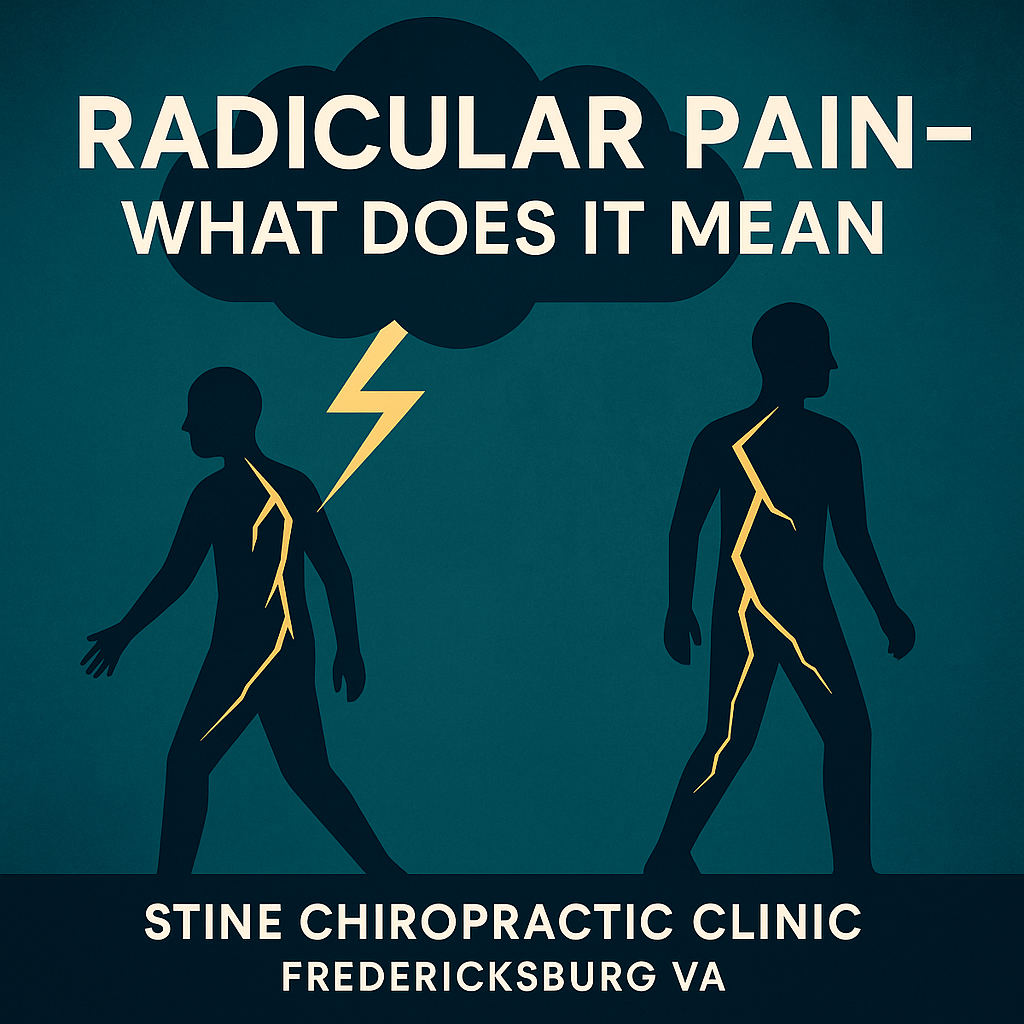Radicular pain is one of the most commonly misunderstood forms of spinal pain. It occurs when a spinal nerve root becomes compressed or irritated, leading to radiating pain, numbness, or weakness that follows a specific nerve pathway known as a dermatome. Unlike referred or myofascial pain, radicular pain follows a predictable pattern along the course of the affected nerve, often extending from the spine into the arm or leg. At Stine Chiropractic Clinic in Fredericksburg, VA, our board-certified chiropractic orthopedists specialize in identifying these dermatomal patterns to determine the exact source of nerve irritation. Accurate diagnosis is the keystone to effective, conservative care and recovery.
What Is Radicular Pain?
Radicular pain originates from the spinal nerve roots that exit the spinal cord through small openings called foramina. When these nerve roots are compressed or inflamed—commonly by a herniated disc, foraminal stenosis, or degenerative joint changes—they can send sharp, electric-like pain signals along the nerve’s distribution. This is what patients often describe as ‘sciatica’ in the leg or ‘pinched nerve’ in the neck.
Radicular pain differs from dull, aching referred pain. It tends to be sharper, more focused, and often accompanied by sensory symptoms such as tingling, burning, or numbness. In some cases, patients may also notice muscle weakness or changes in reflexes depending on which nerve root is affected.
Common Symptoms and Dermatomal Patterns
Each spinal nerve root corresponds to a specific area of skin known as a dermatome. When a particular nerve root becomes irritated, the resulting symptoms—pain, numbness, or tingling—appear in the region supplied by that nerve. Recognizing these dermatomal patterns helps the chiropractic orthopedist pinpoint the exact level of nerve involvement and differentiate between spinal and peripheral nerve causes.
Some common examples include:
- Cervical radiculopathy:
– C5: Pain or weakness in the shoulder and upper arm.
– C6: Numbness or tingling into the thumb and index finger.
– C7: Pain or weakness down the triceps and into the middle finger.
– C8: Symptoms into the ring and little finger. - Lumbar radiculopathy:
– L4: Pain or numbness in the thigh and knee region.
– L5: Symptoms radiating into the outer leg and top of the foot.
– S1: Pain traveling down the back of the leg into the calf and heel.
Because dermatomal mapping is so precise, it is one of the most important diagnostic tools for identifying the specific level of nerve root irritation. This accuracy guides treatment and helps avoid unnecessary procedures.
Accurate Diagnosis: The Key to Effective Care
At Stine Chiropractic Clinic, diagnosis forms the foundation of every treatment plan. Determining whether symptoms arise from a compressed nerve root, a muscle-based referral, or a joint dysfunction requires careful examination and testing. Our chiropractic orthopedists perform comprehensive neurological evaluations that include reflex testing, muscle strength assessment, and sensory evaluation to map the affected dermatome.
When necessary, advanced imaging such as X-ray or MRI can confirm findings and reveal the underlying cause of compression. This diagnostic precision allows our team to tailor care to each individual’s condition—treating the true source of pain, not just the symptoms.
Conservative Chiropractic Orthopedic Treatment
Radicular pain does not always require surgery. Many cases can be successfully managed through conservative, non-invasive care. At Stine Chiropractic Clinic, we use evidence-based treatments designed to relieve nerve pressure, reduce inflammation, and restore motion.
Treatment options may include:
- Spinal manipulation and mobilization to restore joint mechanics and relieve compression.
• Interferential current therapy and ultrasound to decrease inflammation and pain.
• Mechanical traction or decompression therapy to gently relieve pressure on affected nerve roots.
• Targeted rehabilitation exercises to strengthen supportive musculature and prevent recurrence.
Combining these approaches promotes natural healing, improves mobility, and helps patients avoid unnecessary medications or surgical intervention.
When to Seek Evaluation
Patients should seek immediate evaluation if they experience worsening pain, progressive weakness, or changes in coordination or reflexes. Red flag symptoms such as bowel or bladder dysfunction or saddle anesthesia may indicate severe nerve compression and require urgent assessment.
Early evaluation by a board-certified chiropractic orthopedist ensures accurate diagnosis, timely management, and the best chance for full recovery.
Expert Care for Radicular Pain in Fredericksburg, VA
If you’re experiencing sharp, shooting pain, numbness, or tingling that radiates into your arms or legs, it may be a sign of radicular pain or nerve root irritation. At Stine Chiropractic Clinic, our orthopedic team specializes in diagnosing and treating these complex conditions through conservative, patient-centered care.
Contact us today to schedule a comprehensive evaluation and take the first step toward lasting relief.
Stine Chiropractic Clinic — Fredericksburg, VA
117 Redwood Drive, Fredericksburg, VA 22408
540-898-4100 | stinechiro.com
Frequently Asked Questions About Radicular Pain
What’s the difference between radicular pain, referred pain, and myofascial pain?
Radicular pain is caused by nerve root irritation or compression, leading to pain that follows a specific nerve or dermatome pattern. Referred pain comes from joint or tissue irritation that causes pain in a nearby region, while myofascial pain stems from muscle trigger points. Each requires a different diagnostic approach, making accurate diagnosis critical.
Is radicular pain the same as sciatica?
Not exactly. Sciatica refers specifically to irritation of the sciatic nerve or its roots (L4-S3). Radicular pain can occur anywhere along the spine, including the neck (cervical radiculopathy) or lower back (lumbar radiculopathy).
Can radicular pain go away on its own?
In mild cases, symptoms may improve with rest, posture correction, and conservative therapy. Persistent or worsening symptoms should be evaluated by a chiropractic orthopedist to rule out serious nerve compression.
How is radicular pain diagnosed?
Diagnosis involves neurological testing, muscle strength evaluation, sensory mapping of dermatomes, and orthopedic examination. Imaging such as MRI may be used to confirm the site of nerve root irritation.
What are the treatment options for radicular pain?
Treatment focuses on relieving nerve pressure through spinal adjustments, decompression therapy, physical rehabilitation, and soft tissue therapies. In rare cases where conservative care is not effective, patients may be referred for co-management with other specialists.
When should I seek immediate medical care?
If you experience sudden weakness, numbness in both legs, changes in bladder or bowel control, or loss of balance, seek immediate care. These symptoms can indicate severe nerve compression or spinal cord involvement.







